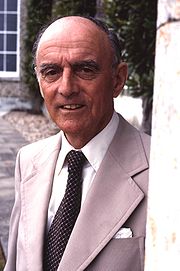Frederick Gordon-Lennox, 9th Duke of Richmond
|
His Grace The Duke of Richmond |
|
|---|---|

Portrait by Allan Warren
|
|
| Born | 5 February 1904 |
| Died | 2 November 1989 (aged 85) |
| Title | Duke of Richmond |
| Tenure | 7 May 1935 – 2 November 1989 |
| Other titles | 9th Duke of Lennox 9th Duke of Aubigny (France) 4th Duke of Gordon 9th Earl of March 9th Earl of Darnley 4th Earl of Kinrara 9th Baron Settrington 9th Lord Torbolton Hereditary Constable of Inverness Castle |
| Successor | Charles Gordon-Lennox, 10th Duke of Richmond |
| Spouse(s) | Elizabeth Grace Hudson |
| Issue |
Charles Henry Gordon-Lennox, 10th Duke of Richmond Lord Nicholas Charles Gordon-Lennox |
| Parents |
Charles Gordon-Lennox, 8th Duke of Richmond Hilda Madeline Brassey |
Frederick Charles Gordon-Lennox, 9th Duke of Richmond, 9th Duke of Lennox, 9th Duke of Aubigny, 4th Duke of Gordon (5 February 1904 – 2 November 1989) was a British peer, engineer, racing driver, and motor racing promoter.
Freddie Richmond, as he was known, was the son of Charles Gordon-Lennox, 8th Duke of Richmond. He was educated at Eton College and Christ Church, Oxford. His interest in engineering started while he was at university and afterwards he was apprenticed to Bentley Motors. He began a motor racing career in 1929 when he took part in the JCC High Speed Trial. In the next year he became a member of the Austin team and won the Brooklands 500 Miles. He created his own team of MG Midgets in 1931 and won the Brooklands Double Twelve race, but then became more involved in the organisational side of motor sport.
He inherited the Dukedoms in 1935, along with the Goodwood Estate and the racecourse. Death duties meant he had to sell the family interests in Scotland, including Gordon Castle, and settle on the Goodwood Estate near Chichester. He designed and flew his own aircraft and served with the Royal Air Force during World War II. For a time he was based in Washington, working for the Ministry of Aircraft Production.
After the war he faced the task of rehabilitating Goodwood, and saw the potential for creating a motor racing circuit from the fighter station built at Goodwood during the Second World War. Horse racing was an important part of the Goodwood scene, but he did not share his ancestors' interest in the sport. The Goodwood Circuit became an important venue in motor racing. However, by 1966 the Duke was concerned at the increasing risks involved in motor racing and closed the circuit except for minor club activities and private testing.
The Duke was the longest-serving Vice President of the Royal Automobile Club, with which he was associated since 1948. As early as the thirties, he was the motoring correspondent of the Sunday Referee, and became the Founder President of the Guild of Motoring Writers.
...
Wikipedia
